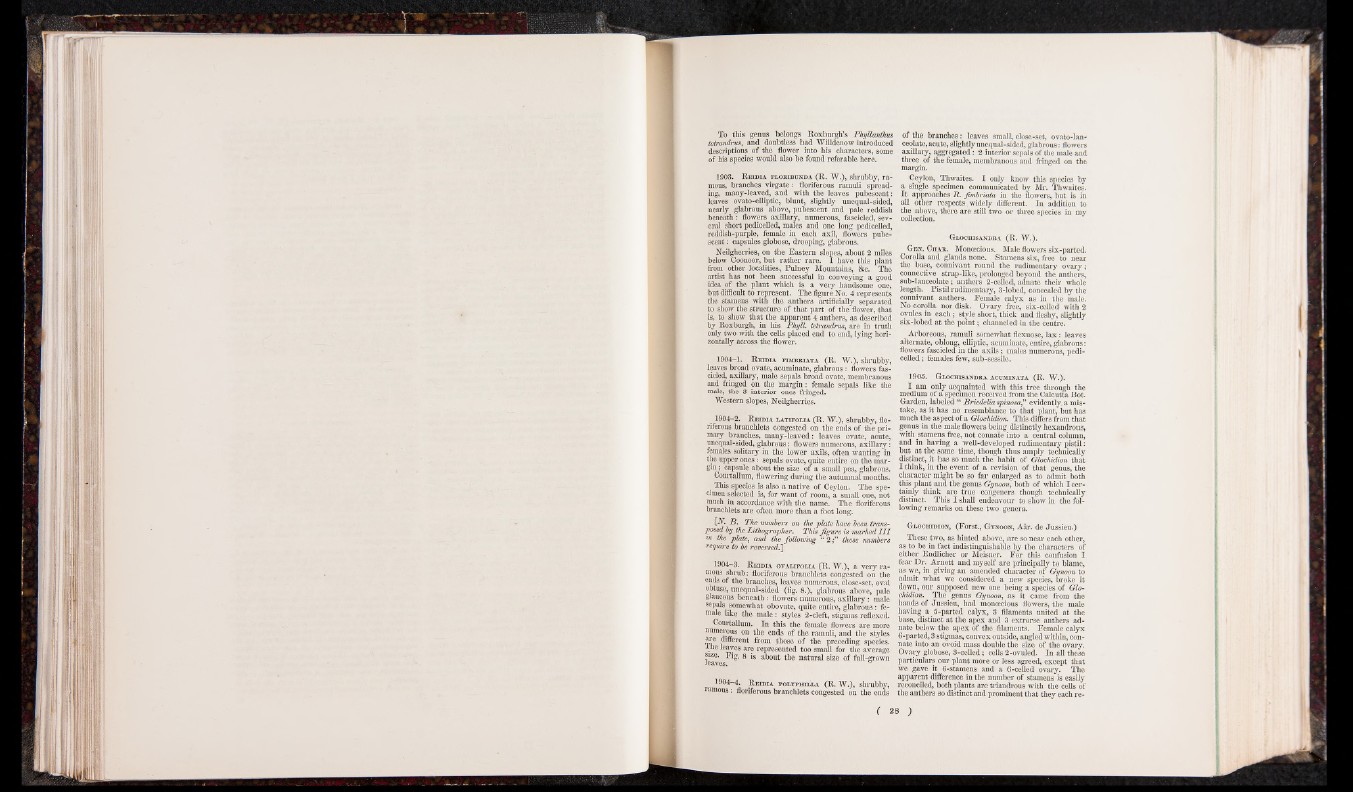
To this genus belongs Roxburgh’s Phyllanthus
tetrandms, and doubtless had Willdenow introduced
descriptions of the flower into his characters, some
of his species would also be found referable here.
1903. Reidia floribunda (R. W.), shrubby, ra-
mous, branches virgate: floriferous ramuli spreading,
many-leaved, and with the leaves pubescent:
leaves ovato-elliptic, blunt, slightly unequal-sided,
nearly glabrous above, pubescent and pale reddish
beneath : flowers axillary, numerous, fascicled, several
short pedicelled, males and one long pedicelled,
reddish-purple, female in each axil, flowers pubescent
: capsules globose, drooping, glabrous.
Neilgherries, on the Eastern slopes, about 2 miles
below Coonoor, but rather rare. I have this plant
from other localities, Pulney Mountains, &c. The
artist has not been successful in conveying a good
idea of the plant which is a very handsome one,
but difficult to represent. The figure No. 4 represents
the stamens with the anthers artificially separated
to show the structure of that part of the flower, that
is, to show that the apparent 4 anthers, as described
by Roxburgh, in his PhyU. tetrandms, are in truth
only two with the cells placed end to end, lying horizontally
across the flower.
1904-1. Reidia fimbriata (R. W.), shrubby,
leaves broad ovate, acuminate, glabrous: flowers fascicled,
axillary, male sepals broad ovate, membranous
and fringed on the margin: female sepals like the
male, the 3 interior ones fringed.
Western slopes, Neilgherries.
. 1904-2. Reidia latifolia (R. W.), shrubby, floriferous
branchlets congested on the ends of the primary
branches, many-leaved: leaves ovate, acute,
unequal-sided, glabrous: flowers numerous, axillary:
females solitary in the lower axils, often wanting in
the upper ones: sepals ovate, quite entire on the margin;
capsule about the size of a small pea, glabrous.
Courtallum, flowering during the autumnal months.
This species is also a native of Ceylon. The specimen
selected is, for want of room, a small one, not
much in accordance with the name. The floriferous
branchlets are often more than a foot long.
L-^ P- The numbers on the plate have been transposed
by the Lithographer. This figure is marhed I I I
m the plate, and the following “ 2 ;” these numbers
require to be reversed.]
1904-3. Reidia ovalifolia (R. W.), a very ra-
mous shrub: floriferous branchlets congested on the
ends of the branches, leaves numerous, close-set, oval
obtuse, unequal-sided (fig. 8.), glabrous above, pale
glaucous beneath: flowers numerous, axillary: male
sepals somewhat obovate, quite entire, glabrous: female
like the male: styles 2-cleft, stigmas reflexed.
Courtallum. In this the female flowers are more
numerous on the ends of the ramuli, and the styles
HH different from those of the preceding species.
. 6 leaves are represented too small for the average
size. Fig. 8 is about the natural size of full-grown
1904-4. R eidia polyphilla (R. W .), shrubby,
ramous: floriferous branchlets congested on the ends
( i
of the branches: leaves small, dose-set, ovato-lan-
ceolate, acute, slightly unequal-sided, glabrous: flowers
axillary, aggregated: 2 interior sepals of the male and
three of the female, membranous and fringed on the
margin.
Ceylon, Thwaites. I only know this species by
a single specimen communicated by Mr. Thwaites.
I t approaches R. fimbriata in the flowers, but is in
all other respects. widely different. In addition to
the above, there are still two or three species in my
collection.
Glochisandra (R. W.).
Gen. Char. Monoecious. Male flowers six-parted.
Corolla and glands none. Stamens six, free to near
the base, connivant round the rudimentary ovary;
connective strap-like, prolonged beyond the anthers,
sub-lanceolate; anthers 2-celled, adnate then- whole
length. Pistil rudimentaiy, 3-lobed, concealed by the
connivant anthers. Female calyx as in the male.
No corolla nor disk. Ovary free, six-celled with 2
ovules in each; style short, thick and fleshy, slightly
six-lobed at the point; channeled in the centre.
Arboreous, ramuli somewhat flexuose, la x : leaves
alternate, oblong, elliptic, acuminate, entire, glabrous:
flowers fascicled in the axils; males numerous, pedicelled
; females few, sub-sessile.
1905. Gxochisandra acuminata (R. W.).
I am only acquainted with this tree through the
medium of a specimen received from the Calcutta Bot.
Garden, labeled “ JBriedeliaspinosa,” evidently, a mistake,
as it has no resemblance to that plant, but has
much the aspect of a Glochidion. This differs from that
genus in the male flowers being distinctly hexandrous,
with stamens free, not connate into a central column,
and in having a well-developed rudimentaiy pistil:
but ^ at the same time, though thus amply technically
distinct, it has so much the habit of Glochidion that
I think, in the event of a revision of that genus, the
character might be so far enlarged as to admit both
this plant and the genus Gynoon, both of which I certainly
think are true congeners though technically
distinct. This I shall endeavour to show in the following
remarks on these two genera.
Glochidion, (Forst., Gynoon, Aar. de Jussieu.)
These two, as hinted above, are so near each other,
as to be in fact indistinguishable by the characters of
either Endlicher or Meisner. For this confusion I
fear Dr. Arnott and myself are principally to blame,
as we, in giving an amended character of Gynoon to
admit what we considered a new species, broke it
down, our supposed new one being a species of Glochidion.
The genus Gynoon, as it came from the
hands of Jussieu, had monoecious flowers, the male
having a 5-parted calyx, 3 filaments united at the
base, distinct at the apex and 3 extrorse anthers adnate
below the apex of the. filaments. Female calyx
6-parted, 3 stigmas, convex outside, angled within, connate
into an ovoid mass double the size of the ovary.
Ovary globose, 3-celled; cells 2-ovuled. In all these
particulars our plant more or less agreed, except that
we gave it 6-stamens and a 6-celled ovary. The
apparent difference in the number of stamens is easily
reconciled, both plants are triandrous with the cells of
the anthers so distinct and prominent that they each re-
3 )